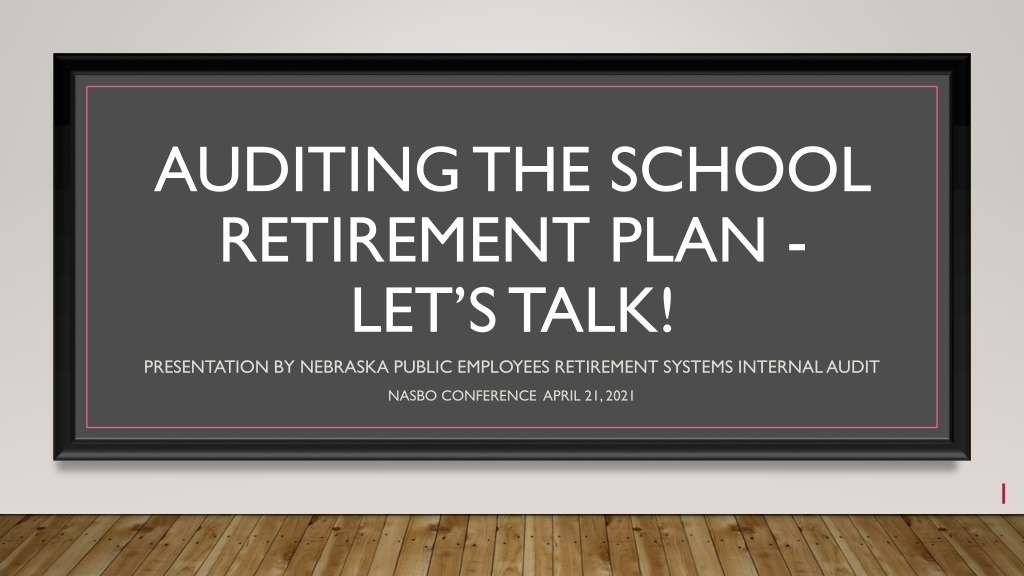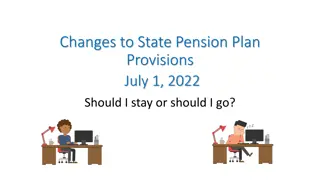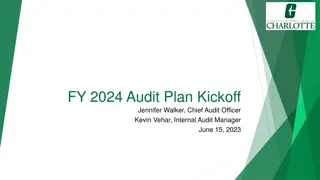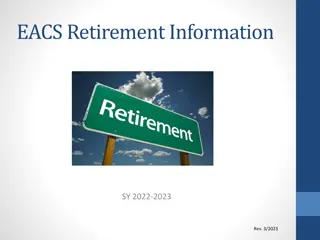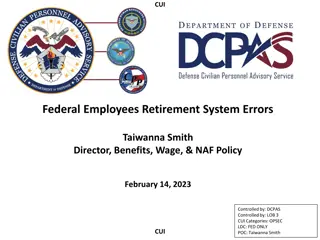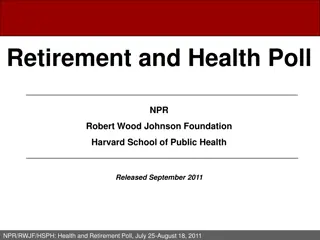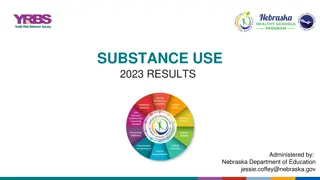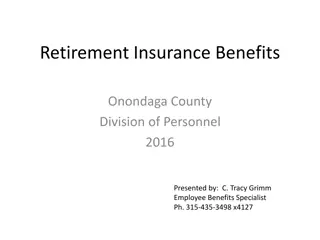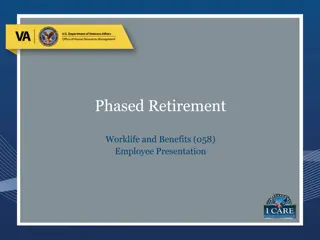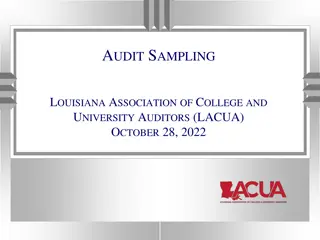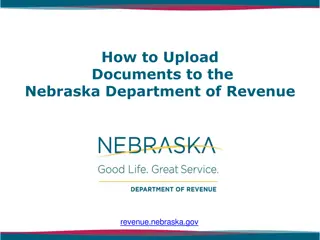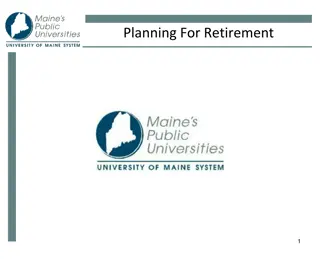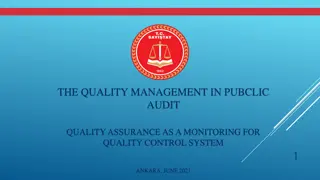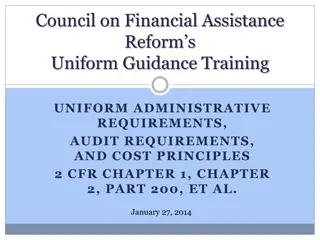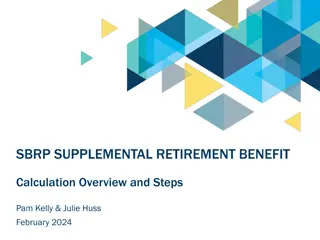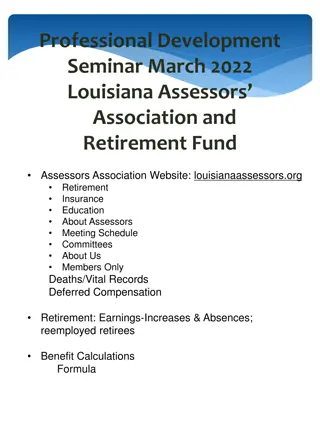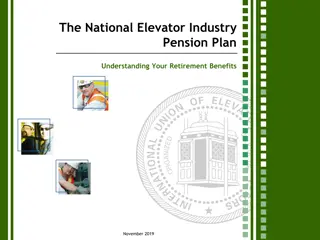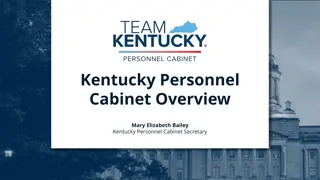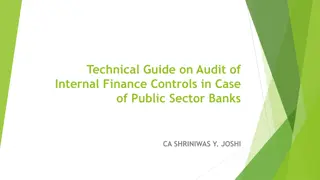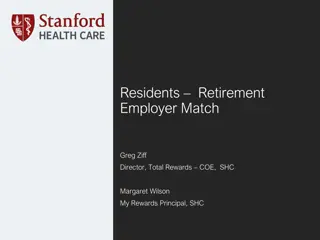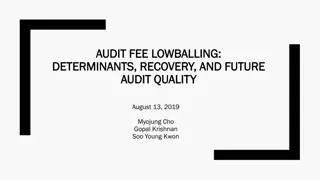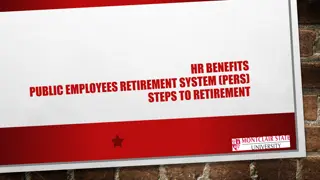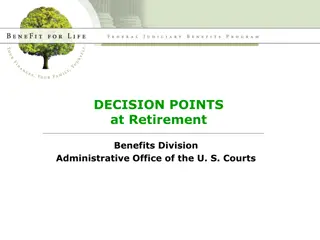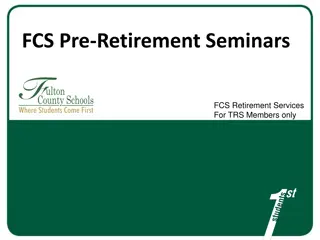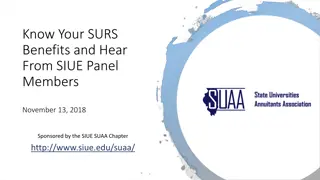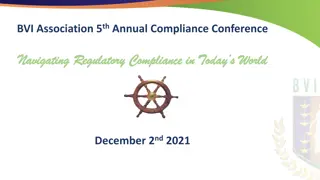School Retirement Plan Audit Presentation by Nebraska Public Employees Retirement Systems Internal Audit
The presentation by Nebraska Public Employees Retirement Systems' Internal Audit team discusses the proactive steps taken to ensure compliance with school retirement plan requirements, the audit process, and the importance of analyzing employee hours. The team emphasizes the significance of internal controls in reviewing school payroll records for accuracy and eligibility of employees enrolling in the plan.
Download Presentation

Please find below an Image/Link to download the presentation.
The content on the website is provided AS IS for your information and personal use only. It may not be sold, licensed, or shared on other websites without obtaining consent from the author. Download presentation by click this link. If you encounter any issues during the download, it is possible that the publisher has removed the file from their server.
E N D
Presentation Transcript
AUDITING THE SCHOOL RETIREMENT PLAN - LET S TALK! PRESENTATION BY NEBRASKA PUBLIC EMPLOYEES RETIREMENT SYSTEMS INTERNAL AUDIT NASBO CONFERENCE APRIL 21, 2021 1
NPERS INTERNAL AUDIT When it s your school s turn for an audit then what? Internal Audit Taking proactive steps to cut down on errors and confusion THEME FOR TODAY Following school retirement plan requirements INTRODUCTIONS Calculating a monthly average of 20 hours or more per week in each calendar month Working through the audit process Analyzing employee hours Q & A Box 2
TIM BAKER Internal Auditor Manager 402-471-2056 INTERNAL tim.baker@nebraska.gov AUDIT JONATHAN NEWCOMB Internal Auditor 402-471-7075 jonathan.newcomb@nebraska.gov TEAM VANESSA HOHLEN Internal Auditor 402-471-8763 vanessa.hohlen@nebraska.gov 3
THEME FOR THE DAY FOLLOWING SCHOOL RETIREMENT PLAN REQUIREMENTS 4
INTERNAL AUDIT Following good internal controls, NPERS reviews school payroll records to ensure all eligible employees enroll in the Plan, the proper amount of contributions are withheld and reported, and employee information is documented and accurate. Taking proactive steps to cut down on errors and confusion. 5
I RECEIVED MY INITIATION AUDIT LETTER NOW WHAT? Why (Nebraska Revised Statute. 84-1503.04,) Contact Information Due date for reply Audit checklist (organization of materials) Prefer documentation to be received electronically Protect PII Reduce Follow ups What's usually missing 7
EXAMPLE CHECKLIST A.Please Provide a copy of your March 2020 Payroll Register Detail (all employees). Include payroll summary information/reports. B.A copy of your School Districts 2019-2020 Master or Negotiated Agreement to include salary scale information The Following Employees have been selected for Payroll testing: C.For the above employees please provide the following 1.Social Security Number 2.Address Information 3.Date of Birth 4.Date of Hire 5.Employment position D.For the employees who were selected for payroll testing (identified above) please also provide: 1.Copy of their 2019-2020 Employment Agreement to include hourly wage or annual salary amounts 2.If the employee is an hourly employee, you will need to provide an hours report (February 2020) that is applicable to the wages that were paid on the March 2020 payroll detail 3.If the employee is not an hourly employee, you will need to explain how you determined the amount of hours that were reported to NPERS for the March 2020 reporting period (be specific). i)If the employee worked extra duties during the 2019-2020 school please indicate what reporting period(s) those extra duty hours were reported. 4.For those selected employees, you will need to review their March 2020 payroll detail to determine if additional documentation is required. If gross wages paid included compensation in addition to their monthly salary, you must provide documentation to support the additional amount that was paid. i)All gross wages must be accounted for ii)Please confirm there were no benefits paid or included in salaries. E.For all Non-Contributing employees, who did not contribute to retirement, on the March 2020, Payroll Register Detail please provide the following: 1.Provide a copy of their payroll register detail for each monthJuly 2019 June 2020. i)You will also need to provide documentation to support why the employee is not enrolled in the retirement plan ii)Each month should be accounted for iii)If the employee did not work during a reporting period, you must indicate zero hours worked. iv)Not True Substitutes: if your payroll register details identifies units as actual hours worked, we will accept a payroll register detail report as documentation. v)For Bus Drivers, please confirm that units represent actual hours worked and not the total amount of routes. 2.Please provide an hours or payroll report that indicates how many hours the employee worked each month during the July 2019-June2020. i)This is necessary if your payroll report does not identify hours actually worked. 8
SCHOOL EMPLOYER QUESTIONNAIRE - PAGE 1 - PART A - PART B - PART C SCHOOL BACKGROUND INFO PLAN ENROLLMENT OF EMPLOYEES WAGE & CONTRIBUTIONS INTERNAL CONTROLS INFO - FINAL AUDIT LETTER - What we found and what to do - 20 days 9
Lets first define the different categories of employees for retirement purposes ANALYZING Substitute employee EMPLOYEE Regular/permanent employee HOURS Temporary employee 10
Who is a substitute employee for retirement purposes? Who is not a substitute employee for retirement purposes? SUBSTITUTE EMPLOYEE 11
WHAT IS THE DIFFERENCE? WHO IS A SUBSTITUTE WHO IS NOT A SUBSTITUTE A person hired by a public school (or ESU) as a regular employee A person hired by a public school (or ESU) as a temporary employee On an ongoing basis To assume the duties of a regular employee And assume the duties of other regular employees who are temporarily absent Due to a temporary absence of any regular employee In other words: A substitute IS NOT a permanent substitute! 12
A is hired by a school district to temporarily fill in for regular employees when they are temporarily absent. A does not work any extra duties for the employer and will sit by the phone and wait for a call to come to work. A is a substitute employee. Does the employer need to track hours for A? A. No, substitutes are not eligible for retirement and therefore, there is no reason to track hours. B. Yes, although the hours are not reportable and A does not qualify for retirement, you must track hours and whom they substitute for. This provides documentation that A is a substitute employee. The hours tracked are also needed should this employee pick up extra ongoing, regular hours. C. No, hours are never tracked for substitutes. We pay them and track them on a days worked basis. D. No, I track who they substituted for, but there is no need to track hours. 13
CORRECT ANSWER: B. Yes, although the hours are not reportable and A does not qualify for retirement, you must track hours and whom they substitute for. This provides documentation that A is a substitute employee. The hours tracked are also needed should this employee pick up extra ongoing, regular hours. 14
REGULAR/PERMANENT EMPLOYEE **MANDATORY PARTICIPATION** From date of hire Becomes eligible 15
REQUIRED PARTICIPATION FROM DATE OF HIRE Hired in a regular full-time or part-time position Who works a full-time or part-time schedule On an ongoing basis For 20 or more hours per week 16
BECOMES ELIGIBLE THEN MANDATORY PARTICIPATION Hired to provide less than 20 hours per week, but Who ends up providing service for an average of 20 or more hours per week In any (does not need to be consecutive) 3 calendar months of a plan year (July 1 to June 30) Once the employee becomes eligible, they are deemed a regular employee for all future employment with the same employer and must begin making retirement contributions with the next payroll period 17
B is hired as a regular employee to work an average of 20 or more hours a week, but less than 40 hours a week, on an ongoing basis. B is immediately enrolled in retirement and starts contributions. After 3 months of employment, B is asked to pick up occasional shifts for other regular employees who are temporarily absent. We know it is important to track hours worked for the regular employment so that the correct amount of creditable service is reported. Does this employer need to track hours for the extra shifts B picks up when other regular employees are temporarily absent? A. No, these extra hours are substitute hours, therefore, not it is not eligible compensation for retirement contributions. B. No, these extra duty shifts are only logged as days because they are substitute shifts. They do not need to be tracked or reported. C. Yes, these hours are not true substitute hours as B is already a regular employee with this employer and contributing to retirement. These hours need to be tracked and added together with the hours worked during B regular employment to ensure the correct amount of creditable service is reported. D. Oh geez, this question makes me want to retire! 18
CORRECT ANSWER: C. Yes, these hours are not true substitute hours as B is already a regular employee with this employer and contributing to retirement. These hours need to be tracked and added together with the hours worked during B regular employment to ensure the correct amount of creditable service is reported. 19
C is hired as a permanent employee to drive a bus 15 hours a week on an ongoing basis. C starts to fill in for other bus drivers when they are temporarily absent. Again, we already know we need to track the regular ongoing hours spent driving a bus (not bus routes worked.) Does this employer need to track hours for C when C picks up the additional shifts when temporarily filling in for regular employees who are temporarily absent? A. No, these are substitute hours and are therefore not to be included as they do not qualify to be eligible for retirement purposes. B. Yes, these additional hours are not true substitute hours as C has a permanent, ongoing position with this employer. These hours need to be tracked and added together with C s regularly scheduled hours to ensure C is not working an average of 20 or more hours a week in any 3 calendar months of a plan year, which would require C to be enrolled in the plan and begin contributions with the next payroll period. C. I feel like there is a theme happening here. Picking this answer because I m just not sure. D. No, hours for substitute shifts are not even tracked because we use days and not hours, therefore it would not make any sense to track hours worked for these shifts. 20
CORRECT ANSWER: B. Yes, these additional hours are not true substitute hours as C has a permanent, ongoing position with this employer. These hours need to be tracked and added together with C s regularly scheduled hours to ensure C is not working an average of 20 or more hours a week in any 3 calendar months of a plan year, which would require C to be enrolled in the plan and begin contributions with the next payroll period. 21
D is hired as a regular employee working 40 hours a week. D is immediately enrolled in retirement and starts contributions. After six months, D begins temporarily filling in for regular employees who are temporarily absent. Part A Does this employer need to track hours for D s regular employment? A. No, they are already eligible and enrolled in the plan so there is no reason to track and report hours worked. They work over 1,000 hours anyway and will receive a full year of creditable service. B. Yes, although the hours worked will be over 1000 hours a year, it is still important to track hours. If something happens in the year where D is unable to work the full year, they need to receive the correct amount of service credit for the portion of the year worked. C. No, we just track an average number of hours based on the number of days in the contract and number of days worked that month. D. This question seems too simple and I feel like it is a trick question. 22
CORRECT ANSWER: B. Yes, although the hours worked will be over 1,000 hours a year, it is still important to track hours. If something happens in the year where D is unable to work the full year, they need to receive the correct amount of service credit for the portion of the year worked. 23
D is hired as a regular employee working 40 hours a week. D is immediately enrolled in retirement and starts contributions. After six months, D begins temporarily filling in for regular employees who are temporarily absent. Part B Does this employer need to track hours for D s hours when D fills in for regular employees who were temporarily absent? A. This question is giving me a headache. B. No, these are substitute hours and are not eligible for compensation under the retirement Plan. C. No, because we only need to track days worked and not hours. D. Yes, these cannot be considered true substitute hours as D is already a regular employee at this employer and contributing to retirement. These hours also need to be tracked in case something happens in the year where D is unable to work the full year. This will ensure D receives the correct amount of service credit for the portion of the year they worked. 24
CORRECT ANSWER: D. Yes, these cannot be considered true substitute hours as D is already a regular employee at this employer and contributing to retirement. These hours also need to be tracked in case something happens in the year where D is unable to work the full year. This will ensure D receives the correct amount of service credit for the portion of the year they worked. 25
TEMPORARY EMPLOYEE LIMITED PERIOD OF TIME NOT TO EXCEED ONE YEAR TO ACCOMPLISH A SPECIFIC TASK OR PURPOSE ONCE TASK IS COMPLETE, THE EMPLOYEE TERMINATES 26
E is hired by a school district as a substitute to temporarily fill in for regular employees when they are absent. After 4 months, E also picks up hours cleaning the building for 2 hours a day, three days a week, on an ongoing basis. E is no longer a substitute once E starts working on an ongoing basis cleaning the building. Does this employer need to track hours for E? A. I m confused. Is this question asking if the employee is a substitute and starts picking up extra ongoing shifts, do I need to track hours for the substitute position and/or the extra shifts? No. Substitute is not eligible and the other shifts are not eligible because it s only 6 hours a week. B. No, substitutes are not eligible and I only track the days worked. The other hours are not enough to track. C. Yes, as E now has a permanent position cleaning the building for 2 hours a day, E can no longer be just a substitute employee. All hours for both positions must be tracked to ensure timely and proper enrollment in retirement if B works an average of 20 or more hours a week in any 3 calendar months of the plan year (July 1 to June 30). D. No, the employee is a substitute first which makes all hours ineligible for retirement purposes. 27
CORRECT ANSWER: C. Yes, as E now has a permanent position cleaning the building for 2 hours a day, E can no longer be just a substitute employee. All hours for both positions must be tracked to ensure timely and proper enrollment in retirement if B works an average of 20 or more hours a week in any 3 calendar months of the plan year (July 1 to June 30). 28
Regardless of category, all employees must have their hours tracked every time they render service, at the time they render service, to ensure they receive the correct retirement benefit! THEME OF ANALYZING HOURS 29
LETS DO SOME MATH TOGETHER! Get ready for polling question #6 30
F is hired by a school district to work part-time. Most weeks he works under 20 hours a week, but during the busy months, he can work over 20 hours a week. How do you do the calculation to determine if he is over the average of 20 or more hours a week in any 3 calendar months of a plan year (July 1 to June 30)? A. Each work week has to be 20 or more hours for me to consider it an eligible month. B. I take the total number of hours worked in the month, divide that by the actual number of days in the month, and multiply that by 7 to get the average number of hours worked in the month. C. I use my payroll calendar to make the determination. If they have more than 80 hours for the payroll detail, regardless if there are other months within the payroll cycle that month, then that is an eligible month. D. I take out any non-working days within the month and divide the total number of hours by how many weeks are actually worked in the month. 31
Take the number of hours worked in one calendar month Divide that by the actual days in the calendar month Multiply that by 7 (days in the week) Equals the number you need to use in determining the average hours worked in one calendar month These do not need to be consecutive months!! CORRECT ANSWER 32
LETS LOOK AT AN EXAMPLE FOR FEBRUARY 2020 Take the number of hours worked in one calendar month 82.50 Divide that by the actual days in the calendar month 29 Multiply that by 7 (days in the week) Your total of average hours worked per week in the calendar month 19.913 82.50 hours / 29 days in February X 7 = 19.913 average hours worked in a week in February 33
CHANGE IT UP SLIGHTLY BY ADDING ONLY 30 EXTRA MINUTES WORKED ANYTIME IN THE MONTH Original NOT ELIGIBLE 82.50 hours / 29 days in February X 7 = 19.913 average hours worked in a week in February Adding 30 minutes - ELIGIBLE 83 hours / 29 days in February X 7 = 20.03 average hours worked in a week in February 34
NEW EXTRA DUTY AND SUBSTITUTE TRACKING FORMS ARRIVING SOON!!! Monthly extra duty log Extra duty log worksheet Monthly substitute log Substitute log worksheet **We strongly encourage you to distribute these to staff for them to fill out and return to you for necessary documentation 35
